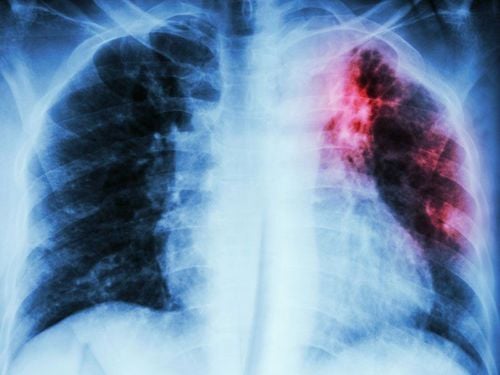This is an automatically translated article.
Article written by Doctor Nguyen Ngoc Phu - ICU Doctor - Intensive Care Department - Vinmec Times City International General Hospital
Pericardial aspiration is used in cases where the patient has pericardial effusion, which affects heart function. This technique will help aspirate pericardial fluid so that the heart can resume functioning, avoiding continued accumulation of fluid in the pericardial capsule.
1. Why should pericardial aspiration?
Normally the pericardial cavity contains 15-50ml of fluid. When a patient has a pericardial effusion, the clinical presentation depends mainly on the amount and rate of fluid or blood in the pericardial cavity. The most severe manifestation is a decline in ventricular function, causing a decrease in cardiac output, a drop in blood pressure and possibly cardiac arrest.
Use of bedside ultrasonography allows emergency department physicians to rapidly assess pericardial fluid, identify left ventricular failure causing acute tamponade, and require immediate pericardiocentesis.
2.When is pericardial aspiration needed?
2.1 Indications Emergency pericardiocentesis: Patients with suspected acute tamponade have life-threatening hemodynamic changes. Non-emergency pericardiocentesis: Aspirate pericardial fluid in hemodynamically stable patients to diagnose the cause.
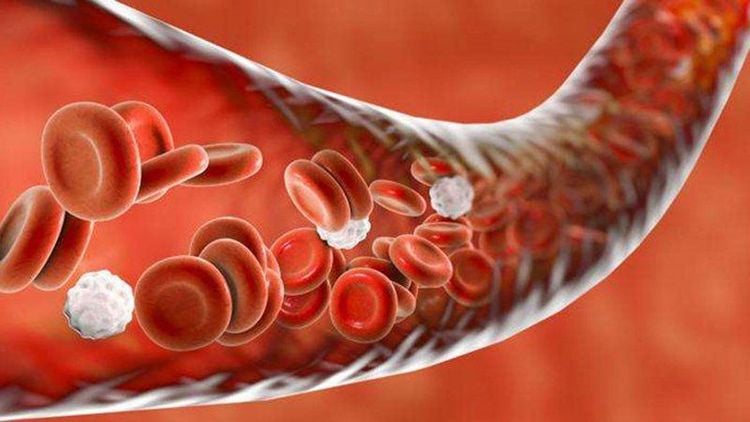
Trường hợp rối loạn đông máu chống chỉ định với phương pháp chọc hút dịch màng tim
2.2 Contraindications Uncorrected coagulopathy. Small amount of pericardial effusion
3.Preparation for pericardial aspiration technique under ultrasound guidance
3.1 Means and instruments Usually a prepackaged pericardial puncture kit is available, including:
18 gauge needle (can use 18 gauge CSF needle) 50ml, 20ml syringe Lidocaine 1%, 10-20ml
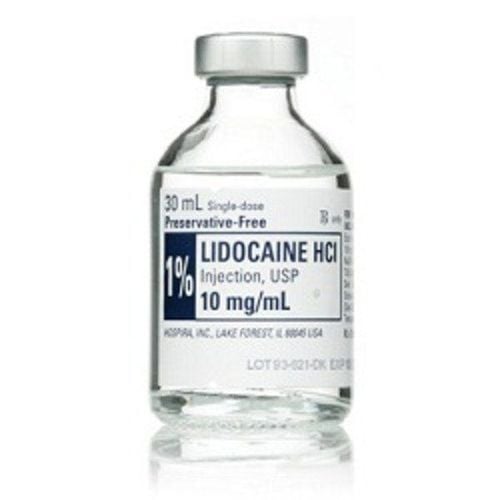
Thuốc tê Lidocain 1% thuộc bộ dụng cụ chọc dò dịch màng ngoài tim
Disinfectant solution: Betadine Sterile gloves, gauze, cap, gasoline Monitor for continuous monitoring of electrocardiograms Bedside ultrasound machine Gloves with sterile ultrasound transducer Clamp wire connects the puncture needle to V1 of the ECG monitor Figure 3.2 Patient The patient is in the lying position with the head 30-45 degrees above the bed to localize the fluid below the pericardial cavity, can lie on the back.
3.3 Medical records Explain the technique to the patient and patient's family and sign the agreement to agree to the technique, the record of the procedure.
4.Steps to perform pericardial aspiration technique under the guidance of ultrasound
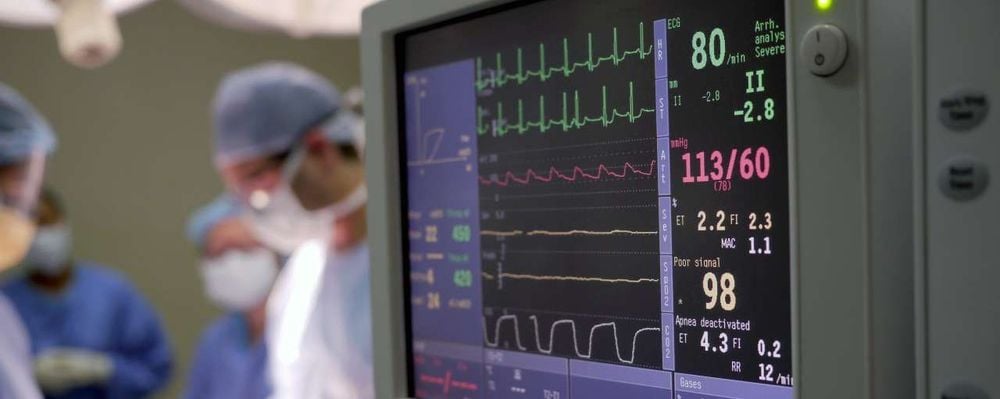
Bệnh nhân cần đặt monitor theo dõi liên tục điện tim và SpO2
Place a secure intravenous line. Oxygen breathing glasses frame Set monitor to continuously monitor ECG and SpO2 Determine anatomical landmarks: the most commonly used sites are below the sternal line (marfan line) and left sternal border (dieulafoy line). 4.1 Technique to determine pericardial fluid by ultrasound The location of the commonly used ultrasound transducer is below the sternal tip and in the longitudinal axial view of the sternal side. However, the best transducer position depends on many factors including the patient's position.
4.1.1 Pericardial puncture by the substernal line (marfan line) The ultrasound probe is placed transversely at the left rib margin and the nasopharynx directs the ultrasound beam to the patient's left shoulder.
The closest structure to the transducer, shown at the top of the screen is the liver considered as a marker Under the liver is the right ventricle Pericardial fluid is a homophonic structure surrounding the heart Underside of the sternal surface of the heart with effusion pericardium.
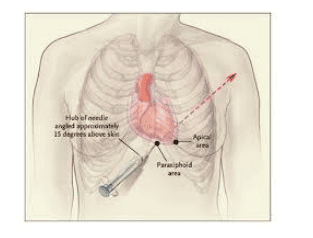
Chọc dò dịch màng ngoài tim theo đường dưới mũi ức đường marfan
4.1.2 Peristernal pericardiocentesis (dieulafoy line) The ultrasound probe is placed on the left sternal edge between the second and fourth intercostal spaces. We clearly see the left atrium, mitral valve, left ventricle and descending aorta Look for pericardial fluid surrounding the heart.
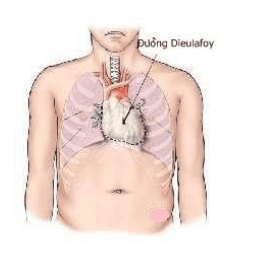
Chọc dò dịch màng ngoài tim theo đường cạnh ức đường dieulafoy
4.2 Probe technique Disinfect the puncture site with antiseptic solution, spread sterile gasoline and local anesthetic with 1% lidocaine. The chest wall is covered with sterile gloves. The ideal location for a percutaneous needle puncture is where fluid is most abundant and close to the chest wall. Ultrasonic transducer coated with gel and sterile gloves, placed in one of the two positions mentioned above. Identify pericardial fluid on the monitor as negative space. The distance from the transducer to the pericardial fluid can be estimated on an ultrasound machine. Using a 16-18 gauge needle attached to a 20 or 50 ml syringe, insert the edge of the ultrasound probe through the chest wall into the pericardial cavity. If time permits, clamp electrode V1 with the probe needle. Slow needle puncture, both inserting and sucking the negative pressure suction cylinder until the fluid is released, when the puncture should observe the electrocardiogram to see if there is a sudden change in the electrocardiogram wave due to touching the heart muscle wall. When the syringe is aspirated, keeping the needle in place, install three prongs, one to the cylinder, the other to the sterile bag. Collect fluid for testing and aspirate pericardial drainage if indicated. Remove needle when pericardial fluid is gone.
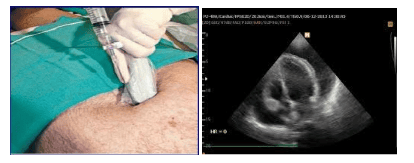
Kỹ thuật chọc dò
5.Common complications and complications
5.1 Cardiac wall perforation Manifestations: ST elevation at the electrode attached to the needle, appearance of extrasystoles, bright red blood aspiration.
Treatment: withdraw the needle immediately, monitor the progress, if the pericardial hemopericardium worsens, emergency surgery is required.
5.2 Cardiac Arrhythmias Commonly caused by deep needle insertion into the heart causing extrasystoles, episodes of tachycardia or bradycardia.
Treatment: must remove the needle immediately.
5.3 Pneumothorax Can be seen with left parathoracic puncture (dieulafoy line), causing left pneumothorax.
Management: like pneumothorax (aspiration, air drainage)
5.4 Perforation of hollow viscera, puncture of the liver Seen with nasogastric puncture.
Handling: close monitoring, handling depending on the situation.
Vinmec International General Hospital is one of the hospitals that not only ensures professional quality with a team of leading medical doctors, modern equipment and technology, but also stands out for its examination and consultation services. comprehensive and professional medical consultation and treatment; civilized, polite, safe and sterile medical examination and treatment space. Customers when choosing to perform tests and treat diseases here can be completely assured of the accuracy and high efficiency in the treatment process.
Please dial HOTLINE for more information or register for an appointment HERE. Download MyVinmec app to make appointments faster and to manage your bookings easily.








